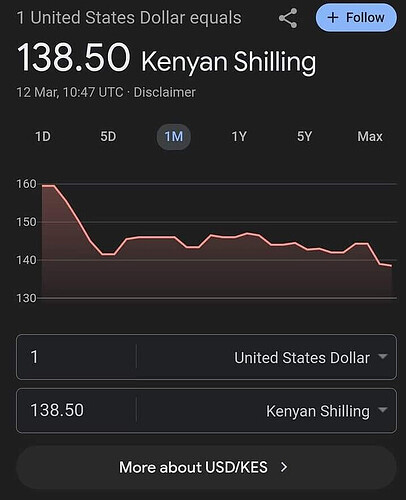Foreign exchange experts have warned Kenyans that the shilling is set to weaken in the coming days against the United States Dollar.
In their report, the analysts noted the local currency was projected to weaken due to high demand for the dollar by the fuel retailing companies.
According to the experts, there was pressure on foreign exchange caused by fuel companies who demanded more Dollars to purchase petroleum from oil-producing countries.
“Kenya’s shilling was stable on Thursday, but it could weaken in coming days due to demand from fuel retailing companies,” noted the analysts.
As at Thursday, May 16, commercial banks quoted the shilling at 130.00/131.00 per dollar, the same as Wednesday’s closing rate.
It is worth noting that the dollars are crucial for traders seeking to facilitate trade on the international markets, a major factor that contributed to the high demand for the US currency.
The shilling was also projected to weaken due to the recent gains by the Dollar witnessed in recent weeks that have caused several currencies to drop in value.
The local currency made consecutive gains in recent weeks which saw it strengthen against major currencies in the world.
A recent report by the World Bank ranked the Kenyan shilling as the best-performing currency in the Sub-Saharan region.
The shilling’s gain was majorly attributed to the increased coffee and tea exports by Kenya to other countries and increased diaspora remittances.
Recently, the Non-governmental organisation was also lauded for its role in the strengthening of the local currency through its dollar inflows to Kenya.
Another significant factor that led to the shilling’s stability was the oversubscription of the infrastructure bonds and the repayment of the Ksh310 billion ($2 billion) Eurobond.
Meanwhile Kenya ranked at position 130 among the worst countries for quality of life, the World Citizenship Report showed.
The ranking, which surveyed wealthy individuals in 188 countries for the sector, placed the country in the position tying with Cameroon after garnering a score of 50.8 points.
Monaco led in the sector with a score of 90.9 per cent followed by Denmark, Hong Kong, Finland and Sweden.
“Our global survey of High-Net-worth-Individuals (HNWIs)’ priorities indicated that ‘Quality of Life’ was the most important factor when considering citizenship for 36.9 per cent of participants. Monaco, Denmark, and Hong Kong took the top spots for Quality of Life in 2024, reflecting the high standard of living and wealth these jurisdictions can extend to all their citizens,” read the report in part.
“Our research indicates that the issues which lend themselves to an improved quality of life matter more than ever to HNWIs. When asked, ‘In what areas, if any, do you feel your current government is failing?’ respondents indicated that healthcare, environmental sustainability, and a competitive economy were needs that were not being met by their governments.”
The report further indicated that the level of quality of life was instrumental in HNWIs’ drive to migrate and seek another citizenship.
Globally, the report showed that the quality of life, which tends to measure countries’ standard of living, is cautiously optimistic for 2024 compared to 2023.
“With a gradual reduction in cost of living compared to the highs of 2023, households in countries such as the United Kingdom (UK), India, and the US will find a slightly lessened burden on living standards,” added the report.
The report further ranked citizenships on the basis of safety and security, economic opportunity, global mobility, and financial freedom.
In the safety and security section, Kenya was ranked at position 121 while in the economic opportunity report, the country appeared at position 91.
For global mobility, Kenya appeared at position 86 while in financial freedom, the country nosedived to position 111.
“The methodology of the WCI combines qualitative and quantitative research to make sense of the deep, enduring quality of citizenship through the lens of the HNWI investor. Uniting our unparalleled work in the citizenship solutions industry with data taken from 188 jurisdictions, we used the country data to evaluate five motivators of citizenship,” explained the report.
“We subsequently scored countries’ citizenships out of 100 points for each motivator, with the overall ranking a weighted average of the motivators.”
The Africa Wealth Report 2024 indicated that the number of dollar millionaires in Kenya (those with a net worth of more than Ksh130 million) stood at 7,200 in 2023
The figure was a drop from the previous year’s 7,700 due to instability in the property market as well as issues at the stock exchange market.


